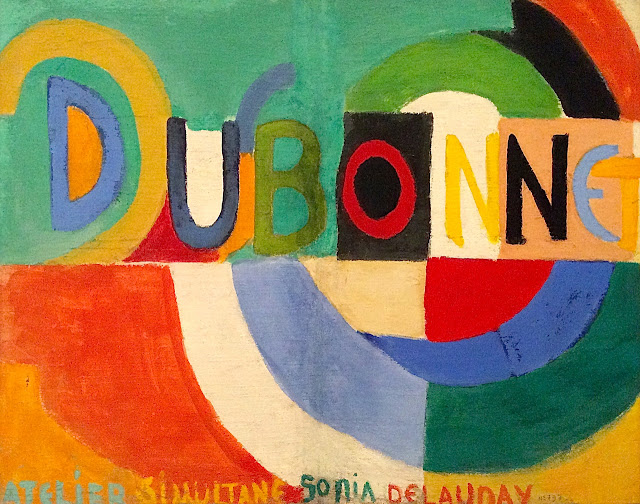Although Sonia thought of herself primarily as a painter, she is widely admired for her work in fashion and the applied arts.
Background: Sonia was born Sara Stern to a poor Jewish Ukrainian family. At the age of five she went to live with her wealthy uncle Henri Terk and his wife, Anna, in St Petersburg, Russia. The Terks offered her a privileged and cultured upbringing in St Petersburg. She adopted their last name, and used her nickname, Sonia.
Training: The Terk family traveled widely in Europe, introducing Sonia to art museums and galleries. When Sonia was 16 she attended secondary school. One of her teachers noticed her drawing skill and suggested that she attend an art academy in Germany. She studied there until she was 20.
In 1905, Sonia moved to Paris and enrolled in a painting academy. She also studied the Post-Impressionist art she saw in the galleries.
Private life: When she was 23, Sonia married a gay German art critic and dealer named Wilhelm Uhde. It is assumed that she needed an excuse to stay in Paris, and that he wanted a way to hide his homosexuality.
The following year, 1909, Sonia met artist Robert Delaunay. They became lovers and she divorced Wilhelm. Together, Sonia and Robert became an avant-garde power couple. Their son Charles was born in 1911.
When Sonia's aunt in St. Petersburg died, she bequeathed property to Sonia, and Robert was a minor aristocrat, so the Delaunay's enjoyed a private income.
The Delaunays were on holiday in Spain when the First World War broke out. Instead of returning to Paris, they moved to Portugal.
In 1921, the Delaunays returned to live in Paris. It appears the marriage endured without notable upset for the rest of Robert's life.
Robert Delaunay died in 1941.
During World War II, things were very difficult for Sonia. Being of Jewish heritage she was forced to move frequently during the war, worried that she would be arrested.
In 1964, when she was 79, met author and poet Jacque Damase, who became her partner and nurtured her late career. by arranging numerous gallery exhibitions as well as a major retrospective in 1967.
She died in 1979 at the age of 94.
Career: Sonia first began exhibiting her work around 1909. At that time her style was strongly influenced by Post-Impressionism and Fauvism, dominated by experimentation with strong colors.
Robert Delaunay shared her interest in color and was studying a color theory that analyzed the effects that colors have on each other when placed next to each other. Both artists began making paintings that were experiments in color and design that they called simultanéisme, in reference to viewing two colors or designs simultaneously.
When her son was born, in 1911, Sonia turned to needlework and embroidery for awhile. She claimed that the idea of moving from figurative work to abstract geometric designs came to her from the process of piecing together wonky rectangles and triangles of color for a patchwork quilt to use as a cradle cover. The quilt is considered a breakthrough work.
 |
| Baby Quilt, 1911 |
What's remarkable about this is that Wassily Kandinski, also a Russian, is traditionally credited with the first abstract painting in 1910. Abstraction was an idea whose time had come; Cubism, by breaking down form, led logically to abandoning subject matter altogether.
 |
| Wassily Kandinsky Picture with a Black Arch, 1912 |
 |
| Sonia Delaunay Bal Bullier, 1912-1913 |
 |
| Journey on the Trans-Siberian Railway, 1913 Text by Blaise Cendrar Publication Design by Sonia Delaunay |
In 1917 the Delaunays met Sergei Diaghilev in Madrid. Diaghilev was a Russian impressario who was sitting out the war in Madrid. Diaghilev pointed Sonia toward two types of work. First, he employed her to design costumes for his productions. Second, he helped her open a design house for interior decoration and fashion, called Casa Sonia.
In the early 1920s the Delaunay family returned to Paris. Sonia soon emerged as a leading figure in the global fashion empire based there. Her new design house, Maison Delaunay, was an immediate success. She also designed textiles and accessories for separate sale. Her use of color and geometric pattern had a strong influence on international fashion.
Sonia returned to painting in 1934 when she and Robert were asked to decorate two buildings for a Paris Exposition of Arts and Crafts of for modern life in 1937. Because of the Depression, her design business was falling off anyway.
After the Second World War, Sonia returned to Paris with the goal of securing Robert's legacy.
In the 1950s, Sonia did a series of paintings called Rhythme coloré, that resumed her explorations of the power of color and the inherent rhythm of combining them on canvas.
In the 60s, her partner Jacque Damase, arranged numerous gallery exhibitions of her work as well as a major retrospective in 1967.
Her last project was designing costumes for an important play in 1978; she also published her autobiography that year.
My photos of Sonia's Work:
 |
| Young Girl from Finland, 1907 Pompidou / Jan's photo |
 |
| Cendrars No. 928, 1913 Seattle / Jan's photo, 2014 |
 |
| La Prose du Transsibérien, 1913 LACMA/Jan's photo, 2017 |
 |
| Rhythm, 1938 Pompidou / Jan's photo |
Internet Examples:
 |
| Dubonnet, 1914 |
 |
| Electric Prisms, 1914 |
 |
| Composition 35, 1930 |
 |
| Composition 24, 1930 |
 |
| Composition 39, 1930 |
 |
| Rhythm Colour no. 1076, 1939 |
 |
| Rhthme Colore, 1952 |
 |
| Color Rhythm, 1967 |
You can follow the progress of Sonia's output here: Sonia at Wikiart.


